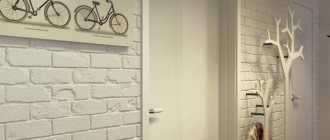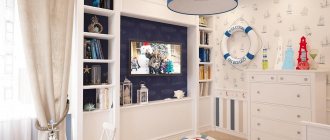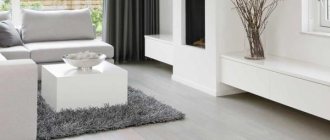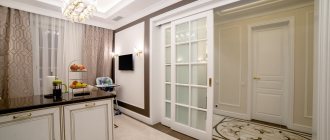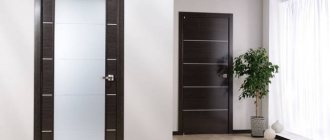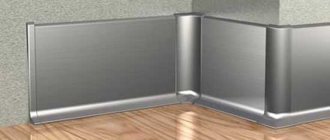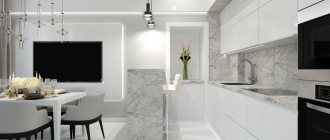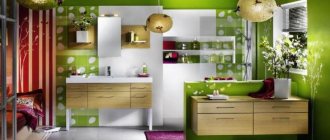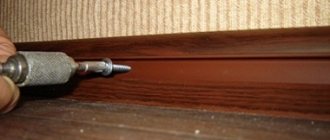The use of skirting boards in the interior has a long, centuries-old history. It is impossible to imagine a modern house or apartment without the use of floor and ceiling fillets. These elements are not only practical, but also aesthetic, they add completeness and help in adjusting the visual perception of the space of the room. White plinth in the interior is well suited for many design solutions and is very popular with most decorators.
Light white plinth in design
Wall with white plinth
White plinth in the interior
The role of baseboards in the interior of a room
One of the finishing touches in the renovation is the installation of fillets. Many people think that they are used for only one purpose - to close the joints between walls and the floor or ceiling. In fact, it has much more functions.
Practical functions:
- closes gaps and joints between walls and floor or ceiling;
- is a holder for floor coverings, for example, linoleum or carpet;
- becomes a cable channel for laying wires.
- The “boot” is needed to prevent the appearance of dirt on the lower parts of the walls.
Installation of fillets for decorative purposes is widely used in the renovation of apartments and houses. Various types, colors, shapes and materials allow you to give the interior a finished look or add a touch of special design.
Wall with white plinth
Light white plinth in design
See also: Benefits of white interior.
Advantages and disadvantages
Using white plinth in the interior has its advantages and disadvantages.
The advantages of its use when performing interior finishing work:
- versatility of color, which will allow it to fit into absolutely any color scheme and interior style;
- white color visually accentuates the structure and shade of the flooring and visually expands the area of the room;
- a white border will never “overload” the interior, but will give it a feeling of lightness and weightlessness;
- white fillet is always stylish simplicity, which is relevant at all times.
In addition, as practice and reviews show, such a plinth is very easy to install, allows cables to be laid unnoticed and has a relatively low cost. It also does not require additional processing of the external coating and can withstand all temperature changes, which is important in heated rooms depending on weather conditions.
Disadvantages of using white skirting boards that must be considered before purchasing it:
- white color, unfortunately, is impractical and very easily soiled, so if small children and pets live in the house, then it is worth considering other finishing options;
- requires constant care;
- To install it, only white fastenings and connections will be required.
As you can see, despite all the shortcomings, there are much more advantages to using white skirting boards.
The building materials market today offers a wide range of flooring and skirting boards. They can be made from different materials. Depending on what type of flooring is used in the interior, the fillet is also selected.
How to choose a plinth
Today, there are various types of fillets on the construction market. They differ from each other in many parameters, for example, by location, material, purpose and other parameters. We will find out which one is better to choose further in our article.
Floor fillets are made of wood, plastic or MDF. Before the appearance of plastic products on the market, the most common were wooden fillets. They have not lost their relevance even now. Wood is the most environmentally friendly material, its service life is from 15 to 25 years. For production, they usually take solid spruce, cedar or pine. Such products can be coated with varnish or stain, as well as painted in any color depending on the overall color scheme.
White plinth in the interior
Wall with white plinth
Light white plinth in design
They are used to frame floors covered with laminate or parquet, as well as natural boards. The price is usually higher than for plastic products, which has led to a decline in popularity in recent decades.
Plastic - easy to install. Even a beginner can handle attaching them. The weight of such products is light; plugs, corner joints and connections are sold complete with them. The color range is presented in a wide range, everyone can choose the color and texture at their discretion. There is no need for painting or special care, unlike wooden ones. In addition, internal channels allow wiring to be laid out and thereby create additional order. As for the disadvantages, we can note low strength and low durability; any blow can provoke cracks and breaks. Such panels are practical for floors covered with laminate, ceramic tiles, linoleum, carpet; they should not be used for parquet or wooden boards.
Those made from MDF are easy to maintain, do not attract dust, are quite inexpensive, but, like plastic ones, are not very durable. They are afraid of moisture; if there is excess humidity, they become deformed and require replacement.
Metal - rarely used, made of aluminum or stainless steel, more often used in rooms with high humidity and a high probability of contamination. In modern apartments they are installed in bathrooms, kitchens and hallways.
White plinth in the interior
Wall with white plinth
The floor profile has a height of 5 to 10 cm, the most popular being 6 cm. It allows you to close all joints and does not visually reduce the height of the walls. Wide 8-10 cm skirting boards in the interior are usually made of plastic and used in large rooms with high ceilings. It gives majesty. Its surface can be either smooth or decorated with protrusions, legs or patterns. The internal design may include ducting for wires and even heating systems.
Ceiling profiles are designed to hide the joints between the ceiling and walls; in addition, they allow you to complete the design, visually control the area and give a special style.
Ceiling moldings have a long history; the palaces of monarchs were decorated with gypsum stucco moldings for many centuries; later, similar, but less massive stucco moldings appeared in apartments built during Stalin’s era. With the advent of planned and uniform construction in our country, stucco moldings were abandoned for many years. Modern designers again turned to stucco moldings and moldings 10-15 years ago and again returned them to their former popularity.
Light white plinth in design
White plinth in the interior
Wall with white plinth
Ceiling fillets are made from various materials, the cheapest being polystyrene foam. Foam stucco moldings can be purchased at any hardware store at very low prices, however, they have a number of disadvantages. They are very fragile, even a slight pressure can leave a dent on them. They must be additionally coated with putty and painted, otherwise they will absorb dust and become dirty very quickly. Due to their fragility, they cannot be washed, and they are also short-lived.
Expanded polystyrene fillets are not much more expensive than those made of polystyrene foam. Their main difference is that they are durable and at the same time quite flexible; they are usually made in white and do not require additional painting.
Light white plinth in design
White plinth in the interior
Wooden ceiling moldings belong to the expensive segment, and not everyone can afford them. They are very heavy, so their installation is quite labor-intensive; all joints must be sawed by hand, and even minor mistakes can ruin the appearance. They are also susceptible to rotting and fungi, and with high humidity they quickly become unusable.
Decorative baguettes, stucco moldings and fillets are most often used in design solutions for wall decoration. For these purposes, they are usually made of polyvinyl chloride, they are decorated with decorative elements or embossing, and can be convex or concave. Such fillets are excellent for decorating frames, wall niches, and are used when working with wall panels and ceramic tiles.
A variety of colors and textures allows you to embody even the most daring design ideas.
Wall with white plinth
Light white plinth in design
White plinth in the interior
See alsoWhite laminate in the interior
Types of skirting boards
Due to wide demand, the variety of products offered on the market is off the charts. The following types of products can be seen on the shelves:
- made of plastic;
- made from MDF;
- metal;
- wooden.
How to attach floor skirting boards is a question that has been relevant since these products appeared. When choosing a product, you must take into account the type of room. Typically, in residential apartments, planks made of plastic and wood are installed. Industrial and office premises are equipped with metal strips. Products made from MDF are used less frequently.
Plastic skirting boards have recently conquered the market. Attaching plastic skirting boards to a concrete wall is a very popular and sought-after installation method in residential premises. By attaching such a strip to the wall, you can disguise the wires. The variety of colors allows you to match the panel to any wall and floor finish. It is not exposed to moisture and sunlight. Thanks to the presence of corners and latches in the baseboard fastening, they can be used to aesthetically decorate any room, including bathrooms.
Plastic products are universal and designed for installation with carpet.
All plastic products can be divided according to the type of base:
- hard, but at the same time fragile, products made of foamed PVC;
- hollow but flexible, rigid PVC products.
The plastic strip should not be confused with a flexible, roll-up print, which is made from polyurethane.
MDF skirting boards are made from wood. On top they are finished with an aesthetic layer of veneer, which can be of different colors. MDF plinth fixed to the wall is indistinguishable from wooden structures, but it is cheaper in cost and this attracts buyers. Although in practice it is less popular due to the fragility of the material. Clips are a way to attach such a plinth. Without sufficient experience it will be difficult to install.
Wooden plinths are much more expensive, but they also look presentable. The wood used to make it is larch, alder, and oak. Wood products are an ecological and natural product. To attach a wooden plinth to the floor, you will need experience and a tool for cutting slats.
Of all the options presented, metal baseboards are the most expensive, but more durable. It is mainly installed in rooms that are used as offices. Recently, warm devices that are based on metal structures have become common. And now people have another question: is it better to install warm floors or warm baseboards? Without some experience it will be difficult to install it. Accurate calculation and cutting of the material will be required.
Interior solutions
Examples of white ceiling and floor plinths in the interior are increasingly found in designer projects. Where such finishing is appropriate and what it is combined with, we will look further.
A white floor plinth in the interior in combination with dark walls or floors gives clarity, delimits the space and indicates a certain rigor. This color for the floor profile will be an ideal solution for apartments in a classic style. It will go well with a white door and give an elegant look.
White fillets are often installed in bright rooms, for example in Swedish style. They go well with light shades of the floor and walls, visually enlarge the space without focusing on clear lines.
Light white plinth in design
Wall with white plinth
The visual perception of the room depends on the width of the white plinth in the interior; if the white color is contrasting with the walls and floor, you need to pay attention to the area and height of the walls. In small, narrow rooms with low walls, you need to select low ones, this will ensure the preservation of space and will not reduce it. If the room is large and the walls are high, you can use a wide white baseboard.
For rooms in light colors, white plinth of any width can be used, since it will not introduce restrictions on the visual perception of the interior.
The combination of white baseboards and white doors is classic. But to dilute such a light design, it is necessary to introduce color contrasts. For example, the color of the walls or floor, or bright decorative elements: furniture, accessories, panels and paintings on the walls.
Light white plinth in design
White plinth in the interior
Wall with white plinth
For the ceiling, most often they resort to white baguettes. Depending on the interior solutions, their width and design vary. Thin white skirting boards are suitable for modern style solutions. If you want to give your room a classic look or embody the Baroque style, you can safely install wide white skirting boards with or without ornaments.
Colored ceiling moldings are rarely installed, since they must be completely combined with the color of the walls or ceiling, unless you plan to change them every time you change the wallpaper or paint the walls, it is better to avoid colored options.
Light white plinth in design
White plinth in the interior
See also Stucco molding in the interior, photo.
Skirting color
White baseboard and white door
The color variety of finishing materials is amazing. Planks are available in a variety of colors, halftones and shades. White skirting boards can be left as is and then painted any color. Do not think that white remains the same in all products: due to the varied structure of the material or surface, the skirting boards may look different.
Wood texture
This type of plank is the most popular because the wood texture is ideal for most types of flooring. Floors made of wood or modern wood-look materials are used in Provence, classic, eco, country and many other styles; accordingly, a “wooden” plinth will look beautiful with the floor. The following fillets imitate the structure of wood:
- plastic;
- laminated;
- veneered;
- from MDF.
The choice of shades is huge: from completely white to dark and shades of natural wood (walnut, alder, oak, ash and others). Positano-look plinth finishing is very popular in the classic style. For this purpose, planks made of white wood, cream, beige with a slight gilding or silvering are used. Typically, to create this effect, solid baseboards are painted in appropriate colors.
Stone texture
In rooms where the walls are tiled (bathroom, kitchen, toilet), as well as in castle-style interiors, it is advisable to use plastic skirting boards with a stone texture. The material can be matched to the color of the tile or laminate. Modern fillets quite accurately imitate the shades of marble, granite and other types of natural stone. White fillets look especially advantageous under:
- marble;
- travertine;
- slate;
- dolomite.
In addition, ordinary plastic planks can be painted to look like stone yourself. For this purpose, special paint and craquelure technique are used. First, thick paint is applied to the surface, then it is refined with a sponge, and new shades are added. In large rooms, wide “stone” planks look beautiful. Typically this technique is used in public institutions.
Color options
In addition to white, there are a huge number of colored skirting boards on sale: plain and with patterns and ornaments. You can buy them ready-made or paint them yourself. Products are also laminated with special films. Colored strips are used for a graphic effect in the interior, in the design of children's rooms, and are suitable for avant-garde styles. If you plan to install a colored baseboard, it is selected in accordance with the shade of the pattern on the wallpaper or the tone of the flooring strips.
The appearance of colored skirting boards can also be different:
- matte;
- glossy;
- smooth;
- rough;
- with shagreen;
- enamel;
- metallized.
Five rules for the bright side of white baseboards
When using a white baseboard, you should remember the following rules.
- It should not only be aesthetically beautiful, but also practical. Choose materials that are easy to clean and do not absorb dirt and dust.
- The color should be in harmony with other colors in the decoration or become a contrast; you should not choose a white baseboard if it does not match the color of the walls, floors and doors.
- Think about the functional features; if you need to hide wires from view, choose fillets with cable channels.
- Select the material from which the white plinth is made depending on the floor covering.
- A white baseboard should not reduce the space of the room; pay attention to its width and choose based on the height of the walls and area.
See also Bleached oak in the interior, photos of color solutions.
Photo selection of interiors with white doors:
See ideas on how you can use white doors in an ordinary apartment.
The final stage of the entire renovation is the installation of skirting boards. A well-chosen framing option will highlight the beauty of the created interior and hide imperfections in the joints or between different surface textures. In addition, the plinth also plays a practical role, hiding the wires.
Today there is a large assortment of skirting boards, varying in size, texture, color, and functional features. With all its diversity, white plinth remains an unchanged classic and can be combined with any interior design. It complements it and can change the overall geometry of any room. Therefore, when choosing a white skirting board, you need to know the rules of its use and installation features.
